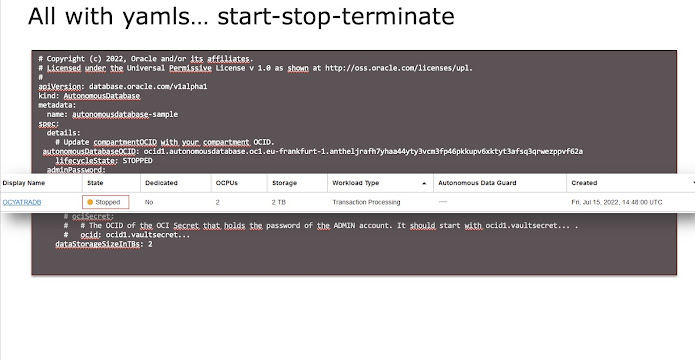In the fast-changing world of tech, the fusion of databases with Kubernetes is an important topic. Oracle, worked already for quite some time at a cool solution to simplify this merge: the Oracle Database Operator for Kubernetes, also known as OraOperator. This tool is made to help developers, DBAs, DevOps, and GitOps teams cut down the time and complexity involved in deploying and managing Oracle Databases within Kubernetes environments.
The OraOperator is an example to Oracle's commitment to making the Oracle Database Kubernetes-native. This means that the database is observable and operable by Kubernetes, which simplifies many aspects of database administration and operation. The operator extends the Kubernetes API with custom resources and controllers, automating the lifecycle management of Oracle Databases and eliminating the need for a human operator or administrator for the majority of database operations.
One of the key features of the OraOperator is its support for a variety of database configurations and infrastructure. This includes the Oracle Autonomous Database—both shared and dedicated Cloud infrastructure—as well as containerized Single Instance databases and Sharded databases deployed in the Oracle Kubernetes Engine (OKE) and any Kubernetes where OraOperator is deployed. Additionally, it supports Oracle Multitenant Databases and the Oracle Base Database Cloud Service.
The latest release of OraOperator, version 1.1.0, brings several new features and enhancements. These include a namespace scope deployment option, support for Oracle Database 23ai Free with Single Instance Database, automatic storage expansion, user-defined sharding, TCPS support with customer-provided certificates, and the ability to execute custom scripts during database setup and startup. Moreover, it introduces patching for Single Instance Database Primary/Standby in Data Guard and long-term backup for Autonomous Databases.
Oracle's vision for OraOperator is not static; there are more plans to continue extending its capabilities to support additional Oracle Database configurations. This ongoing development reflects Oracle's dedication to innovation and its responsiveness to the needs of the Kubernetes community.
How does it work?
The (OCI) DB Operator for Kubernetes)
- Creating and manage Oracle Databases in containers(k8s pods)
- Containerized Single Instance databases (SIDB) deployed in OKE and any k8s where OraOperator is deployed
- Containerized Sharded databases (SHARDED) deployed in OKE or any k8s where OraOperator is deployed
- Manage Oracle databases outside your k8s cluster:
- Oracle Autonomous Database:
- Oracle Autonomous Database shared Oracle Cloud Infrastructure (OCI) (ADB-S)
- Oracle Autonomous Database on dedicated Cloud infrastructure (ADB-D)
- Oracle Autonomous Container Database (ACD) (infrastructure)
- Provision, bind,
- Scale
- Stop/start/terminate
- Change admin password
- Download wallet for connection
- Oracle Multitenant Databases (CDB/PDBs)
- Oracle Base Database Cloud Service (BDBCS)
- Oracle Data Guard (Preview status)
- Oracle Database Observability (Preview status)
Some of the prerequisites
- Installing the Oracle Database Operator SDK on client machine, if you want to operate from there
- Configure the appropriate OCI Identity (IAM) service policies
- Allow to manage OCI services in your tenancy.
- Install the Operator Lifecycle Manager (OLM) bundle.
- The ORA DB bundle contains all the required details, such as CRDs, RBACs, configmaps, and deployments, which installs it in the Kubernetes cluster.
It's all about YAML
Create
Scale
Start-stop-terminate
Conclusion (for now)
In conclusion, the Oracle Database Operator for Kubernetes represents a significant step forward in the integration of cloud database services with container orchestration platforms. By leveraging the power of Kubernetes, organizations can achieve greater agility, scalability, and efficiency in their cloud-native applications. The Oracle Database Operator for Kubernetes is a significant advancement in integrating traditional database systems with modern cloud-native technologies. It simplifies the deployment and management of Oracle Databases, paving the way for more agile and efficient operations. As the Kubernetes ecosystem continues to expand, tools like OraOperator will undoubtedly play a crucial role in bridging the gap between databases and Kubernetes, fostering a more seamless and productive environment for all stakeholders involved.





.png)

